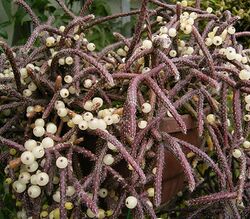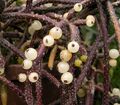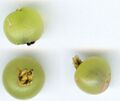Biology:Rhipsalis baccifera
| Rhipsalis baccifera | |
|---|---|

| |
| Scientific classification | |
| Kingdom: | Plantae |
| Clade: | Tracheophytes |
| Clade: | Angiosperms |
| Clade: | Eudicots |
| Order: | Caryophyllales |
| Family: | Cactaceae |
| Subfamily: | Cactoideae |
| Genus: | Rhipsalis |
| Species: | R. baccifera
|
| Binomial name | |
| Rhipsalis baccifera (J.S.Muell.) Stearn
| |
| Synonyms | |
| |
Rhipsalis baccifera, commonly known as the mistletoe cactus, is an epiphytic cactus which originates from Central and South America, the Caribbean, and Florida. It is also found throughout the tropics of Africa and into Sri Lanka where it is known in Sinhala as Script error: The function "transl" does not exist. (නවහන්දි).[2] This is the only cactus species naturally occurring outside the Americas. One hypothesis is that it was introduced to the Old World by migratory birds, long enough ago for the Old World populations to be regarded as distinct subspecies.[3] An alternative hypothesis holds that the species initially crossed the Atlantic Ocean on European ships trading between South America and Africa, after which birds may have spread it more widely.[4]
Taxonomy
The species shows considerable polymorphism and can be divided into numerous subspecies. Mesoamerican specimens are usually tetraploid and South American specimens are diploid. The genera currently assigned to the tribe Rhipsalideae (which include Hatiora, Lepismium, and Schlumbergera in addition to Rhipsalis) were subject to considerable confusion and disagreement prior to the clarification by Wilhelm Barthlott and Nigel Taylor in 1995.[5]
Gallery
-
Branches
-
Flower
-
Fruit
-
Fruit
References
- ↑ Arreola, H.; Hammel, B.; Hilton-Taylor, C.; Ishiki, M.; Loaiza, C.; Nassar, J.; Oakley, L.; Pin, A. et al. (2017). "Rhipsalis baccifera". IUCN Red List of Threatened Species 2017: e.T62378A121561919. doi:10.2305/IUCN.UK.2017-3.RLTS.T62378A121561919.en. https://www.iucnredlist.org/species/62378/121561919. Retrieved 12 June 2021.
- ↑ "Ayurvedic Medicinal Plants of Sri Lanka". http://www.instituteofayurveda.org/plants/plants_detail.php?i=278.
- ↑ Anderson 2001, p. 611.
- ↑ Cota-Sánchez, J. Hugo; Bomfim-Patrício, Márcia C. (2010), "Seed morphology, polyploidy and the evolutionary history of the epiphytic cactus Rhipsalis baccifera (Cactaceae)", Polibotanica 29: 107–129, http://www.herbarium.usask.ca/research/articles/Cota-Sanchez_Bomfim-Patricio_Polibotanica_2010.pdf, retrieved 2012-05-15, pp. 117–118
- ↑ Anderson, Edward F. (2001), The Cactus Family, Pentland, Oregon: Timber Press, ISBN 978-0-88192-498-5, OCLC 44650974, pp. 102, 375
- "Rhipsalis baccifera (J.S. Mueller) Stearn in Cact. J. (Croydon) 7: 107 (1939)". Rhipsalis, Lepismium, Hatiora, Schlumbergera. http://www.rhipsalis.com/species/baccifera.htm.
- "Mistletoe Cactus". Desert-Tropicals.com. http://www.desert-tropicals.com/Plants/Cactaceae/Rhipsalis_baccifera.html.
- Maxwell, Phil (May 1999). "The Rhipsalis Riddle - or the day the cacti came down from the trees: Part 3". New Zealand Cactus and Succulent Journal. http://www.rhipsalis.com/maxwell3.htm.
External links
Wikidata ☰ Q136525 entry
 |






